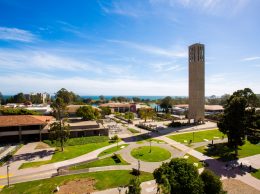Chancellor calls on private sector to support CSU growth
IN THIS ARTICLE
- Top Stories Topic
- Dana Olsen Author
By Dana Olsen Friday, April 26th, 2013
California State University Channel Islands has grown at a rapid clip since it opened its doors in 2002, a pace that’s expected to continue over the next decade as the school depends less on the state for funding and reaches out to the private sector.
Timothy White, who became chancellor of the California State University system at the beginning of the year, visited the Camarillo campus for the first time on April 18. At a news conference, White said the school, which is the only public four-year university in Ventura County, is poised to become one of the system’s success stories.
“It’s actually stunning to see [CSUCI]’s transformation. To see what’s happened in 10 years … it may seem like a glacial pace to the outside world, but for higher education, 10 years is quite remarkable,” White said at the conference. “This will be one of the jewels of the CSU system. There’s no doubt in my mind.”
Part of what makes CSUCI stand out among the system’s 23 branches is the fact that it’s the youngest of the CSU campuses. With 4,920 full-time students enrolled for the 2011-12 school year, the school is also still one of the smallest in the system — by comparison, Cal Poly San Luis Obispo, the only other CSU campus in the Tri-Counties, hosted almost 19,000 full-time students during the same time period. CSUCI’s relatively small enrollment is one reason CSU leadership is focused on expanding the university.
Channel Islands has been one of the only campuses in the CSU system to expand its student body during and after the Great Recession, a statistic that’s partly due to the fact that officials wanted to fill out the young campus.
White said the expansion is expected to continue over the next decade; he told the Business Times be believes CSUCI will “double in size in 10 years.”
The school has grown even as California’s government has slashed its higher education budget: For the 2011-12 school year, for example, California State University received $750 million less than it did the previous year. Still, the Camarillo campus managed to add a thousand students during that time period, largely because as the youngest school in the CSU organization, it received more state funding — the university receives about 70 percent of its budget from the state — than most of its counterparts.
In October 2011, CSUCI President Richard Rush told the Business Times the CSU system agreed to provide its customary financial support to the campus even as it mired in the worst of the state budget cuts. At that time, the state agreed to put its weight behind the organization’s newest school and gave the go-ahead to increase enrollment by 500 students per year, with an ultimate goal of hosting 15,000 full-time students by 2025.
“The argument is that we can become self-sustaining,” Rush said in 2011. “I’m hoping that as we move forward, the CSU system won’t need to underwrite our campus.”
A year and a half later, officials are still hoping to depend on a mix of public and private support to fund the Camarillo campus.
On the public side, Gov. Jerry Brown has proposed legislation that would raise CSU’s budget by a total of $125 million for the 2013-14 school year, money that would go toward freezing tuition and raising faculty salaries in addition to expanding the number of students admitted to the universities. “That’s a very important step in the right direction,” White said at the news conference.
The chancellor added that if the state agrees to the budget hike, the entire CSU system will increase enrollment by about 4 percent each year for the upcoming years. That number is significant for the state because CSU graduates are important to the economy. One out of every 10 employees in California is a CSU graduate, White said.
He said the only possible third avenue for financial support, aside from the state government and student tuition, is the private sector. “You can’t run an economic engine for a community without resources,” White said. “The state bears responsibility for part of it, students bear responsibility for part of it, and one of the things I’ve learned is that this community also bears a large part of the responsibility.”
Specifically regarding Ventura County and its CSU campus, White said businesses are starting to “understand the power of CSU Channel Islands.” One way to connect private businesses to the university, he said, is to start to develop a business incubator located close to the freeway to take advantage of the school’s position along the 101 corridor.
Although White hasn’t yet visited Cal Poly, the other tri-county campus, he told the Business Times he appreciates the efforts President Jeffrey Armstrong is making to better connect that university with businesses in its hometown of San Luis Obispo.










